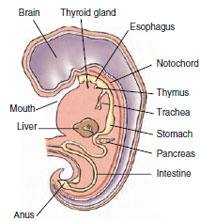Derivatives of Endoderm: Digestive Tube and Survival of Gill Arches
Derivatives of Endoderm:
Digestive Tube and
Survival of Gill Arches
In frog embryos the primitive gut
makes its appearance during gastrulation
with the formation of the archenteron.
From this simple endodermal
cavity develop the lining of the digestive
tract, the lining of the pharynx and
lungs, most of the liver and pancreas,
the thyroid and parathyroid glands,
and the thymus (Figure 8-24).
In other vertebrates the alimentary canal develops from the primitive gut and is folded off from the yolk sac by the growth and folding of the body wall (Figure 8-27). The ends of the tube open to the exterior and are lined with ectoderm, whereas the rest of the tube is lined with endoderm. The lungs, liver, and pancreas arise from the foregut.
Among the most intriguing derivatives of the digestive tract are the pharyngeal pouches, which make their appearance in the early embryonic stages of all vertebrates (see Figure 8-19). During development the endodermally-lined pharyngeal pouches interact with the overlying ectoderm to form gill arches. In fishes, the gill arches develop into gills and supportive structures and serve as respiratory organs. When early vertebrates moved onto land, gills were unsuitable for aerial respiration and were replaced by lungs.
Why then do gill arches persist in the embryos of terrestrial vertebrates? Certainly not for the convenience of biologists who use these and other embryonic structures to reconstruct lines of vertebrate descent. Although the gill arches serve no respiratory function in either embryos or adults of terrestrial vertebrates, they remain as necessary primordia for a variety of other structures. For example, the first arch and its endoderm-lined pouch (the space between adjacent arches) form the upper and lower jaws and inner ear of vertebrates. The second, third, and fourth gill pouches contribute to the tonsils, parathyroid gland, and thymus. We can understand then why gill arches and other fishlike structures appear in early mammalian embryos. Their original function has been abandoned, but the structures are retained for new purposes. The great conservatism of early embryonic development has conveniently provided us with a telescoped evolutionary history.
 |
| Figure 8-27 Derivatives of the alimentary canal of a human embryo. |
In other vertebrates the alimentary canal develops from the primitive gut and is folded off from the yolk sac by the growth and folding of the body wall (Figure 8-27). The ends of the tube open to the exterior and are lined with ectoderm, whereas the rest of the tube is lined with endoderm. The lungs, liver, and pancreas arise from the foregut.
Among the most intriguing derivatives of the digestive tract are the pharyngeal pouches, which make their appearance in the early embryonic stages of all vertebrates (see Figure 8-19). During development the endodermally-lined pharyngeal pouches interact with the overlying ectoderm to form gill arches. In fishes, the gill arches develop into gills and supportive structures and serve as respiratory organs. When early vertebrates moved onto land, gills were unsuitable for aerial respiration and were replaced by lungs.
Why then do gill arches persist in the embryos of terrestrial vertebrates? Certainly not for the convenience of biologists who use these and other embryonic structures to reconstruct lines of vertebrate descent. Although the gill arches serve no respiratory function in either embryos or adults of terrestrial vertebrates, they remain as necessary primordia for a variety of other structures. For example, the first arch and its endoderm-lined pouch (the space between adjacent arches) form the upper and lower jaws and inner ear of vertebrates. The second, third, and fourth gill pouches contribute to the tonsils, parathyroid gland, and thymus. We can understand then why gill arches and other fishlike structures appear in early mammalian embryos. Their original function has been abandoned, but the structures are retained for new purposes. The great conservatism of early embryonic development has conveniently provided us with a telescoped evolutionary history.




